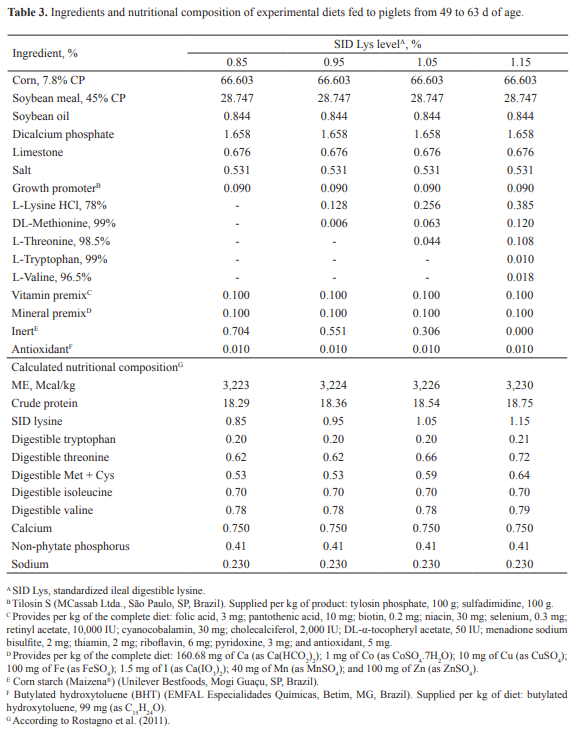Evaluation of the standardized ileal digestible lysine requirement of nursery pigs from 28 to 63 d of age in a three-phase feeding program
Author details:
The objective of this study was to determine the standardized ileal digestible lysine (SID Lys) requirement of nursery pigs from 28 to 63 d of age fed a multi-phase feeding (PF) program and its possible adaptation to SID Lys-deficient diets. Ninety-six commercial hybrid piglets (Topigs Norsvin, 46 castrated males and 50 females) that had been weaned at 28 d of age with an initial body weight of 8.82 ± 0.28 kg were distributed in a randomized block design composed of four treatments, with eight replicates per treatment and three animals per replicate. The treatments were as follows: PF1, SID Lys levels of 1.05, 0.95, and 0.85%; PF 2, SID Lys levels of 1.15, 1.05, and 0.95%; PF 3, SID Lys levels of 1.25, 1.15, and 1.05%; and PF 4, SID Lys levels of 1.35, 1.25, and 1.15% from 28 to 35, 36 to 49, and 50 to 63 d of age, respectively. From 28 to 63 d of age, the average daily feed intake (ADFI) and average daily gain (ADG) were not affected by the SID Lys levels tested; however, final body weight (fBW) was affected, with PF1 having the lowest fBW. The SID Lys levels tested had a significant effect on the feed conversion ratio (FCR), which varied linearly from 28 to 35 d of age. In the period from 28 to 63 d of age, pigs fed PF4 had the highest FCR results. The protein deposition ratio (PDR) was also affected by the SID Lys levels tested, with PF3 and PF4 having the highest PDR results. Therefore, the optimal SID Lys requirement for nursery pigs from 28 to 35 d of age that provided better performance results was 1.25%, corresponding to a daily Lys intake of 4.13 g/d. PF3 provided the best performance and PDR results for piglets from 28 to 63 days of age.
Key words: Amino acid, compensatory growth, nutritional requirement, tissue deposition.




ALEBRANTE, L.; DONZELE, J. L.; Oliveira, R. F. M.; SARAIVA, A.; GUIMARÃES, S. E. F.; FERREIRA, A. S. Níveis de fósforo disponível em rações para suínos de alto potencial genético para deposição de carne magra mantidos em ambiente de termoneutro dos 15 aos 30 kg. Revista Brasileira de Zootecnia, Viçosa, v. 40, n. 2, p. 323-330, 2011.
ASSOCIATION OF OFFICIAL ANALYTICAL CHEMISTS - AOAC. Official Methods of Analysis of AOAC International. 17th ed. AOAC International, USA, 2000.
BAUER, E.; METZLER-ZEBELI, B. U.; VERSTEGEN, M. W. A.; MOSENTHIN, R. Intestinal gene expression in pigs: effects of reduced feed intake during weaning and potential impact of dietary components. Nutrition Research Reviews, Bethesda, v. 24, n. 2, p. 155-175, 2011.
BOUDRY, G.; PÉRON, V.; LE HUEROU-LURON, I.; LALLÈS, J. P.; SÈVE, B. Weaning induces both transient and long-lasting modifications of absorptive, secretory and barrier properties of piglet intestine. Journal of Nutrition, Rockville, v. 134, n. 9, p. 2256-2262, 2004.
BRASIL. Ministério da Agricultura. Instrução Normativa no. 3, de 17 de janeiro de 2000. Regulamento técnico de métodos de insensibilização para o abate humanitário de animais de açougue. Diário Oficial [da] União, Brasília, 2000. p. 14-16.
BUFFINGTON, D. E.; COLLAZO-AROCHO, A.; CANTON, G. H. Black globe humidity index (BGHI) as comfort equation for dairy cows. Transaction of American Society of Agricultural Engineering, Saint Joseph, v. 24, n. 3, p. 711-714, 1981.
CASTILLO, M.; MARTÍN-ORÚE, S. M.; NOFRARÍAS, M.; MANZANILLA, E. G.; GASA, J. Changes in caecal microbiota and mucosal morphology of weaned pigs. Veterinary Microbiology, Geneva, v. 124, n. 3-4, p. 239- 247, 2007.
CHIBA, L. I.; KUHLERS, D. L; FROBISH, L. T. Effect of dietary restrictions on growth performance and carcass quality of pigs selected for lean growth efficiency. Livestock Production Science, Amsterdam, v. 74, n. 1, p. 93-102, 2002.
CLOSE, W. H.; STANIER, M. W. Effects of plane of nutrition and environmental temperature on the growth and development of the early-weaned piglet. 1. Growth and body composition. Animal Production, Central Java, v. 38, n. 2, p. 211-220, 1984.
COLÉGIO BRASILEIRO DE EXPERIMENTAÇÃO ANIMAL - COBEA. Princípios éticos na experimentação animal. São Paulo: Congresso do Colégio Brasileiro de Experimentação Animal, 1991. 1 p.
COLLIN, A.; VAN MILGEN, J.; DUBOIS, S.; NOBLET, J. Effect of high temperature on feeding behaviour and heat production in group-housed pigs. British Journal of Nutrition, Rockville, v. 86, n. 1, p. 63-70, 2001.
DE LANGE, C. F. M.; MOREL, P. C. H.; BIRKETT, S. H. Modeling chemical and physical body composition of the growing pig. Journal of Animal Science, Champaign, v. 81, n. 14, p. E159-E165, 2003.
EDMONDS, M. S.; GONYOU, H. W.; BAKER, D. H. Effect of excess levels of methionine, tryptophan, arginine, lysine or threonine on growth and dietary choice in the pig. Journal of Animal Science, Champaign, v. 65, n. 1, p. 179-185, 1987.
FABIAN, J.; CHIBA, L. I.; KUHLERS, D. I.; FROBISH, L. T.; NADARAJAH, K.; KERTH, C. R.; MCELHENNEY, W. H.; LEWIS, A. J. Degree of amino acid restrictions during the grower phase and compensatory growth in pigs selected for lean growth efficiency. Journal of Animal Science, Champaign, v. 80, n. 10, p. 2610-2618, 2002.
FONTES, D. O.; DONZELE, J. L.; OLIVEIRA, R. F. M.; SILVA, F. C. O.; LOPES, D. C. Níveis de lisina para leitoas selecionadas geneticamente para deposição de carne magra na carcaça dos 15 aos 30 kg. Revista Brasileira de Zootecnia, Viçosa, v. 34, n. 1, p. 90-97, 2005.
GANDRA, E. R.; TRINDADE NETO, M. A.; BERTO, D. A.; BUDINO, F. E. L.; GANDRA, J. R.; SCHAMMASS, E.A. Digestible lysine levels in diets for pigs from 24 to 50 kg under sanitary segregation. Revista Brasileira de Zootecnia, Viçosa, v. 41, n. 9, p. 2039-2047, 2012.
HILL, G. M.; BAIDO, S. K.; CROMWELL, G. L.; MAHAN, D. C.; NELSSEN, J. L.; STEIN, H. H. Evaluation of sex and lysine during the nursery period. Journal of Animal Science, Champaign, v. 85, n. 6, p. 1453-1458, 2007.
KAHINDI, R. K.; HTOO, J. K.; NYACHOTI, C. M. Dietary lysine requirement for 7-16 kg pigs fed wheatcorn-soybean meal-based diets. Journal of Animal Physiology and Animal Nutrition, Berlin, v. 101, n. 1, p. 22-29, 2017.
KENDALL, D. C.; GAINES, A. M.; ALLEE, G. L. Commercial validation of the true ileal digestible lysine requirement for eleven- to twenty-seven-kilogram pigs. Journal of Animal Science, Champaign, v. 86, n. 2, p. 324-332, 2008.
KERR, B. J.; EASTER, R. A. Effect of feeding reduced protein, amino acid supplemented diets on nitrogen and energy balance in grower pigs. Journal of Animal Science, Champaign, v. 73, n. 10, p. 3000-3008, 1995.
KIM, S. W.; BAKER, D. H.; EASTER, R. A. Dynamic ideal protein and limiting amino acids for lactating sows: the impact of amino acid mobilization. Journal of Animal Science, Champaign, v. 79, n. 9, p. 2356-2366, 2001.
KORNEGAY, E. T.; LINDEMANN, M. D.; RAVINDRAN, V. Effects of dietary lysine levels on performance and immune response of weanling pigs housed at two floor space allowances. Journal of Animal Science, Champaign, v. 71, n. 3, p. 552-556, 1993.
MAHAN, D. C.; CROMWELL, G. L.; EWAN, R. C.; HAMILTON, C. R.; YEN, J. T. Evaluation of the feeding duration of a phase 1 nursery diet to three-week-old pigs of two weaning weights. Journal of Animal Science, Champaign, v. 76, n. 2, p. 578-583, 1998.
MAHAN, D. C.; LEPINE, A. J. Effect of pig weaning weight and associated nursery feeding programs on subsequent performance to 105 kilograms body weight. Journal of Animal Science, Champaign, v. 69, n. 4, p. 1370-1378, 1991.
MANNO, M. C.; OLIVEIRA, R. F. M.; DONZELE, J. L.; FERREIRA, A. S.; OLIVEIRA, W. P.; LIMA, K. R. S.; VAZ, R. G. M. V. Effect of thermal environment on performance of growing pigs from 15 to 30 kg. Revista Brasileira de Zootecnia, Viçosa, v. 34, n. 6, p. 1963- 1970, 2005.
MCCRACKEN, B. A.; SPURLOCK, M. E.; ROOS, M. A.; ZUCKERMANN, F. A.; GASKINS, H. R. Weaning anorexia may contribute to local inflammation in the piglet small intestine. Journal of Nutrition, Rockville, v. 129, n. 3, p. 613-619, 1999.
NATIONAL RESEARCH COUNCIL - NRC. Nutrient requirements of swine. 11. ed. National Academy Press, Washington DC, USA, 2012.
NEMECHEK, J. E.; GAINES, A. M.; TOKACH, M. D. Evaluation of standardized ileal digestible lysine requirement of nursery pigs from seven to fourteen kilograms. Journal of Animal Science, Champaign, v. 90, n. 12, p. 4380-4390, 2012.
OLIVEIRA, A. L. S.; DONZELE, J. L.; OLIVEIRA, R. F. M.; ABREU, M. L. T.; FERREIRA, A. S.; SILVA, F. C. O.; HAESE, D. Dietary digestible lysine requirement of barrows with high genetic potential for lean gain in the carcass from 15 to 30 kg. Revista Brasileira de Zootecnia, Viçosa, v. 35, n. 6, p. 2338-2343, 2006.
PLUSKE, J. R.; LE DIVIDICH, J.; VERSTEGEN, M. W. A. Weaning the pig: concepts and consequences. (Ed.). The Netherlands: Wageningen Academic Publishers, 2003. 432 p.
RENAUDEAU, D.; NOBLET, J. Effects of exposure to high ambient temperature and dietary protein level on sow milk production and performance of piglets. Journal of Animal Science, Champaign, v. 79, n. 6, p. 1540-1548, 2001.
ROSTAGNO, H. S.; ALBINO, L. F. T.; DONZELE, J. L.; GOMES, P. C.; OLIVEIRA, R. F.; LOPES, D. C.; FERREIRA, A. S.; BARRETO, S. L. T.; EUCLIDES, R. F. Tabelas brasileira para aves e suínos: composição de alimentos e exigências nutricionais. 3. ed. Editora UFV, Viçosa, MG, Brasil, 2011. 252 p.
______. Tabelas brasileira para aves e suínos: composição de alimentos e exigências nutricionais. 4. ed. Editora UFV, Viçosa, MG, Brazil, 2017. 488 p.
SCHNEIDER, J. D.; TOKACH, M. D.; DRITZ, S. S; NELSSEN, J. L.; DEROUCHEY, J. M.; GOODBANG, R. D. Determining the effect of lysine:calorie ratio on growth performance of ten- to twenty-kilogram of body weight nursery pigs of two genotypes. Journal of Animal Science, Champaign, v. 88, n. 1, p. 137-146, 2010.
SPREEUWENBERG, M. A. M.; VERDONK, J. M. A. J.; GASKINS, H. R.; VERSTEGEN, M. W. A. Small intestine epithelial barrier function is compromised in pigs with low feed intake at weaning. Journal of Nutrition, Rockville, v. 131, n. 5, p. 1520-1527, 2001.
TAYLOR, A. E.; TOPLIS, P.; WELLOCK, I. J.; MILLER, H. M. The effects of genotype and dietary lysine concentration on the production of weaner pigs. Livestock Science, Amsterdam, v. 149, n. 1-2, p. 180-184, 2012.
TRINDADE NETO, M. A.; BARBOSA, H. P.; PETELINCAR, I. M. Dietas para leitões nas fases de creche e diferentes idades ao desmame. Revista Brasileira de Zootecnia, Viçosa, v. 31, n. 2, p. 687-695, 2002.
YANG, Y. X.; GUO, J.; JIN, Z.; YOON, S. Y.; CHOI, J. Y.; WANG, M. H.; PIAO, X. S.; KIM, B. W.; CHAE, B. J. Lysine restriction and realimentation affected growth, blood profiles and expression of genes related to protein and fat metabolism in weaned pigs. Journal of Animal Physiology and Animal Nutrition, Berlin, v. 93, n. 6, p. 732-743, 2009.
YI, G. F.; GAINES, A. M.; RATLIFF, B. W. Estimation of the true ileal digestible lysine and sulfur amino acid requirement and comparison of the bioefficacy of 2-hydroxy-4-(methylthio)butanoic acid and dlmethionine in eleven- to twenty-six-kilogram nursery pigs. Journal of Animal Science, Champaign, v. 84, n. 7, p. 1709-1721, 2006.








.jpg&w=3840&q=75)